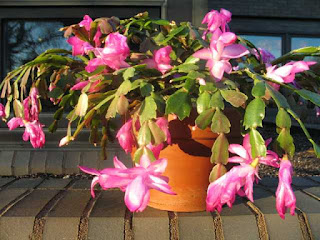Hanging Basket Cactus Plants by Kurt M. Jones, Chaffee County Extension Director
We were greeted last week to our first bloom from our Schlumbergera in our kitchen. This plant was given to us as a holiday gift years ago, and continues to bring us joy now. How many parents can say that about gifts they have given their children? In this tough economy, perhaps a plant is on your planning lists.
One popular plant during this season is the Schlumbergera. This plant is probably better known as the Holiday or Christmas Cactus. This plant is popular because it is a short day length blooming cactus. It is not unusual for this plant to initiate blooming around Thanksgiving, finishing after the New Year celebrations.
Schlumbergeras are native to the tropical forests of South America, where they grow on trees. Their stems are unique, leaves colorful, and timely blossoms make this an attractive addition to indoor plant collections. The stems of Christmas cactus’ (S. buckleyi) are spineless, but produce tubular flowers in a variety of colors at Christmas time.
A close cousin of the Christmas Cactus is the Thanksgiving Cactus (S. truncata), which is similar to the Christmas Cactus, but tends to bloom earlier in the winter. Its stem joints are longer and narrower than its Christmas cousin. Blooms are generally red or white and can be up to 3 inches long.
Another schlumbergera that you may want to add to your collection is the Easter cactus (S. gaertneri). It is often confused with the Christmas cactus, but blooms around Easter and sometimes in the early fall as well. Blooms can be different shades of red or pink, depending on the cultivar.
For springtime blooms, consider the Orchid Cactus. This cactus also works well in hanging baskets, with branches originating from a central crown. It also has showy blooms, which appear throughout the spring into early summer. Varieties are available with yellow, red, orange and white blooms.
Proper care of any of these cactus plants will have the best blooms. These plants enjoy humus-rich soils that are kept moist during their growing periods. Following flowering, allow the soils to dry out between watering. Overwatering any cactus plant can promote root rot, poor growth, and poor flowering. These plants enjoy bright, indirect light from east, south or west windows. Direct sunlight can be harmful to houseplants.
Avoid drafty places when placing these plants. Ideal temperatures for bud set are 40-45° F at night, with daytime temperatures in the 60-65° F range. The remainder of the year, these plants prefer temperatures ranging from 50-55° F at night and 65-70° F during the day. These plants don’t require much pruning and should be replanted infrequently.
